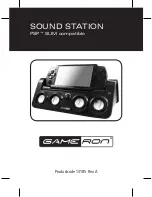
8
AW4-LS-BR & AW6-LS-BR Product Manual
WIRING INFO - 8 OHM OPERATION
Speaker cable
The amount of wire needed varies with speaker placement. Label speaker
wires with left, right, and location.
Use Russound AW series speaker cable or any reputable brand of 16 to 12
gauge multi-stranded wiring for amplifier- to-speaker connections.
Wire is measured in gauges: the greater the number, the smaller the wire. The
gauge of wire needed is determined by the distance between the amplifier/
receiver and the speakers. The longer the run, the heavier the gauge needed.
Use the following chart as a guide:
Length
Minimum Gauge
0' to 100'
16
50' to 150'
14
100' to 200'
12
The standard colors on the terminals are red Positive (+) and black Negative (-).
If the wire has transparent insulation, one conductor will be copper-colored
(+) and the other silver-colored (-). If the wire has an opaque insulation, the
conductors are differentiated by a series of ribs or grooves, a stripe, or dotted
line on one conductor. Use and mark these as the Positive (+) conductor.
Typical usage of speaker wire conductors
-
+
-
+
Tap Setting Knob
When using the AW4-LS-BR speakers
with a low impedance system (such as
with a 4Ω or 8Ω amplifier or receiver),
make sure that the tap setting switch is
set to the 8Ω position. This is the only
appropriate setting when using the
speaker with a low impedance amplifier.
Prewiring
Run a separate 2-conductor stranded copper speaker cable of at least 16 AWG
(1.5 mm) from the amplifier to each speaker.
When running a speaker cable parallel to an AC power cable, keep them at
least 24 inches (60 cm) apart to minimize electromagnetic interference. If the
speaker cables must cross AC wiring, cross them at right angles.
Leave about 2 feet (0.6 m) of cable at each end for connecting to the speakers
and amplifier. Label the cables so you will know which cable connects to each
keypad or amplifier output channel.
• Avoid running speaker wires close to house electrical wiring for any
distance. If you have to run them parallel, leave two feet between the
wiring. Speaker wires should cross AC lines at a 90° angle.
• The entire path between speakers and amplifier should be clear and
unobstructed. Confirm the placement for the wall port close to the
intended location of the amplifier or receiver.
• Label speaker wires at each end with left and right and location.
Impedance matching for amplifiers and speakers
If you intend to use more than one pair of speakers at a time it’s important
to consider both the impedance of the speakers and the capabilities of the
amplifier or receiver. Not all amplifiers or receivers can safely operate two sets
of speakers at once.






























